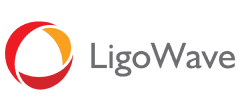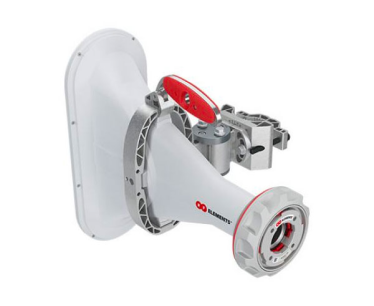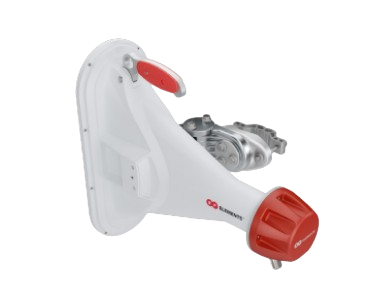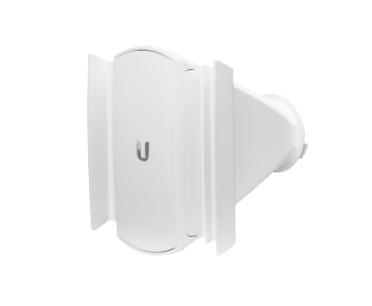6 GHz ePMP 4600L antenna by IsoHorns
The WB6-A90 enhances network reliability, boosts subscriber satisfaction, and significantly improves signal strength, modulation rates, and subscriber speeds.
This horn antenna is perfect for Wireless Internet Service Providers (WISPs) with connects easily to with Cambium 5 GHz ePMP 3000, ePMP 4500, 6 GHz ePMP 4600L, and Ubiquiti 5 GHz Rocket Prism AC, Rocket LTU, and wideband 6 GHz Wave MLO6 and Wave MLO5 MultiPoint Wi-Fi 7 BE radios.
With its future-ready support for the entire 5 and 6 GHz bands, the WB6-A90 is ready for upcoming Wi-Fi 6e AX and Wi-Fi 7 BE technologies, helping you stay ahead of the competition and meet growing customer demands.








Radio Compatibility List

Ubiquiti

Wave MLO 6

Wave MLO 5

Rocket Prism AC Gen2

Rocket LTU

Cambium

ePMP 4600L

ePMP 4500L

ePMP 3000L

Mimosa

Mimosa A5x
Why choose IsoHorns wideband 6 GHz asymmetrical 90° horn antennas?
Wideband flexibility
The WB6-A90 stands out with its remarkable frequency range and RF performance, operating smoothly from 4.9 GHz to 7.2 GHz. This broad spectrum encompasses both the traditional 5 GHz band, commonly used in current wireless setups, and the emerging 6 GHz band. For WISPs, this means the WB6-A90 is not just a solution for today's needs but also a future-proof investment, ready to adapt to evolving wireless technologies.
Exceptional 5 GHz band performance
Engineered for versatility, the WB6-A90 doesn't compromise on performance in the 5 GHz band. It excels where many current Wi-Fi networks and applications operate, offering superior performance even compared to standard 5 GHz antennas. This ensures that your current network infrastructure benefits from enhanced signal quality and reliability, with the potential for improved range and throughput.
Outshines competitors
In head-to-head comparisons, the WB6-A90 goes beyond the standards set by competitors like RF Elements, especially in the 5 GHz range. This isn't just about outperforming others; it's about providing WISPs with a reliable, high-quality solution that makes their services faster and more reliable and increases overall subscriber satisfaction.. With the WB6-A90, WISPs get a level of performance that sets new benchmarks in antenna technology.
Practical for WISPs
For Wireless Internet Service Providers, the WB6-A90 is more than just an antenna; it's a versatile tool designed to enhance network performance today and remain relevant tomorrow. Its wide operating range opens up opportunities for diverse applications, including future transitions to the 6 GHz band. Meanwhile, its robust performance in the 5 GHz band ensures that your existing network doesn't just keep up but gets better, without the need for immediate overhauls or upgrades.
We believe upgrading and optimizing PTMP
wireless networks is critical for WISPs to stay
competitive now and in the future.
IsoHorns' wideband 6 GHz asymmetrical horn antennas greatly surpass the performance of narrowband 5 GHz RF Elements horns in 5 GHz. With our horns, WISP installers will have better success rates because the average station signal strength improves by approximately 4 dB. Our horns also substantially improve signal-to-noise ratios, boosting network reliability and overall subscriber satisfaction. Additionally, our horns enhance competitiveness by increasing average subscriber download speeds by around 40%. Uniquely, our horns fully support the entire 6 GHz band, guaranteeing compatibility with upcoming Wi-Fi 6e AX and Wi-Fi 7 BE technologies, making them a future-proof solution.
6 GHz horn antennas by IsoHorns are the world’s only premium wideband 6 GHz asymmetrical horn antennas for wireless internet service providers (WISPs). As the sole manufacturer globally, IsoHorns specializes in engineering asymmetrical horn antennas specifically designed for the 6 GHz band, covering a broad frequency range from 4.9 to 7.2 GHz. These horn antennas are perfect for unlicensed outdoor wireless point-to-multipoint (PTMP) WISP operations and fixed wireless (FWA) service providers, offering uniform coverage to subscribers, especially when mounted atop WISP towers. Their design ensures a consistent signal distribution, crucial for maintaining reliable connectivity across the service area.
Higher customer installation success rates
Improves average station signal strength by approximately 4 dB and improves modulation rates by 40%, leading to higher WISP installation success rates.
Boost subscriber satisfaction
Migrating subscribers to 6 GHz improves the experience for those still on 5 GHz.
Increase competitiveness
Enhances average subscriber download speeds by around 40%, boosting competitiveness.
Future-proof
Fully supports the entire 6 GHz band, ensuring compatibility with upcoming Wi-Fi 6e AX and Wi-Fi 7 BE technologies.
More reliable network
Substantially boosts signal-to-noise ratios, increasing subscriber satisfaction and retention.
Simplified Spatial Engineering for WISPs
Our 90° Asymmetrical Horn Antenna stands out with its unique coverage approach. Unlike conventional antennas, it offers a 90-degree coverage angle with an asymmetrical distribution. This means enhanced focus in specific directions rather than a uniform spread, making it ideal for targeted coverage. The horn antenna's design excels in delivering uniform signal distribution within its coverage zone while drastically minimizing side lobes. The result? A sharply defined coverage area where signal strength remains consistent and reliable, a crucial feature for WISP operations.
Optimized Coverage with Asymmetrical Design
Spatial Engineering is a critical aspect for WISPs, involving strategic design and placement of network components to maximize coverage, capacity, and performance in a given area. Considering factors like antenna type, location, signal strength, and interference is essential. Our asymmetrical horn antenna is a game-changer in this regard. Its predictable signal distribution and clear-cut coverage boundaries make it an invaluable tool for WISPs. This ease of spatial engineering allows for precise deployment, reducing interference risks with neighboring networks and guaranteeing dependable service to customers.

Key Advantages for WISP Networks
This wideband 6 GHz 90° asymmetrical horn antenna is not just another piece of gear; it's a strategic advantage for WISPs. Its uniform signal distribution and well-defined coverage edges simplify network planning and implementation. With this antenna, WISPs can accurately determine where signal strength will be optimal and areas it won’t reach, optimizing network performance and customer satisfaction. This level of predictability is essential in crowded wireless environments, ensuring minimal interference and maximum reliability for users. Choose our 90° Asymmetrical Horn Antenna for a smarter, more efficient WISP network.
Comparison
Model Number
Frequency Range
Gain
Azimuth Beam Width -6 db
Elevation Beam Width -6 db
Front-to-Back Ratio
Isolation
VSWR Max
Connector
Waveguide

WB6-A90
4900-7200 MHz
18 dBi
90°
25°
40 dB
>30 dB
1.6
RP-SMA male pigtails
Included

AH90WB
5170-7125 MHz
15 dBi
90°
25°
27 dB
-
-
Proprietary
Not included

AH90-TP
5180-6000 MHz
16 dBi
90°
25°
30
-
-
Proprietary
Not included

HG3-CC-A90
5180-6000 MHz
16 dBi
90°
25°
30
-
1.9
N Female
Included

Horn-5-90
5150-5800 MHz
13 dBi
90°
45°
-
17 dB
2.0
Proprietary
Included with radio
Industry Leading VSWR Performance
Wideband 4.9 to 7.2 GHz
Broader Frequency Range
The wideband capability of IsoHorns' antenna covers a broader frequency range (4.9 to 7.2 GHz), which is crucial for unlicensed WISPs. This range includes not only the traditional 5 GHz band but also extends into the 6 GHz band. The ability to operate across a wider range of frequencies allows WISPs to access more spectrum, which is particularly valuable in areas where the 5 GHz band is congested. This congestion is a common issue in many urban and suburban areas where numerous devices and networks compete for bandwidth.
Improved Performance and Reliability
The enhanced performance of the IsoHorns antenna in terms of signal strength and stability can lead to more reliable and efficient service. This is crucial for WISPs aiming to provide high-quality internet connectivity, especially in regions with challenging topographies or where line-of-sight connections are difficult to establish. Better antenna performance can translate into higher data rates and more stable connections, improving customer satisfaction.
Flexibility and Scalability
The flexibility offered by a wideband antenna is significant for WISPs planning to scale their operations or adapt to changing regulatory environments. As regulations evolve and new spectrum bands become available for unlicensed use, having equipment that can operate over a wide range of frequencies means WISPs can adapt more easily without needing to replace their existing infrastructure. This adaptability is especially important in the rapidly evolving telecommunications landscape.
Competitive Advantage
For unlicensed WISPs, using superior technology like IsoHorns' wideband antenna can provide a competitive edge. In an industry where service quality can be a major differentiator, the ability to offer faster, more reliable internet service can help WISPs attract and retain customers.
International Implications
Different countries have different regulations regarding unlicensed spectrum use. An antenna that covers a wider frequency range provides more options for WISPs operating in international markets, where they might encounter a variety of regulatory environments. This versatility can be a key factor in the global expansion strategies of these providers.
Asymmetrical e-Plane horn antennas
Enhanced Coverage in Specific Directions
Asymmetrical horns provide more focused coverage in certain directions compared to symmetrical horns. This is ideal for WISPs needing to target specific areas or communities with better signal strength and reliability.
Reduced Interference
By concentrating the signal in a particular direction, asymmetrical horns minimize interference with neighboring networks. This is crucial in unlicensed spectrum environments where multiple networks often operate in close proximity.
Improved Signal Quality
The focused beam of an asymmetrical horn can lead to a higher signal-to-noise ratio, translating to better data rates and improved overall performance of the network.
Flexibility in Network Design
Asymmetrical horns allow for more tailored network designs. WISPs can efficiently cover areas with irregular shapes or challenging topographies, which might be difficult with symmetrical horns.
Ease of Deployment
Asymmetrical horns can be easier to align and deploy due to their directional nature. This makes the setup process quicker and less labor-intensive.
Cost-Effective
By providing more precise coverage, asymmetrical horns can reduce the need for additional access points or repeaters, leading to cost savings in equipment and maintenance.
Better Client Experience
The focused coverage can lead to fewer dead zones and better connection stability for end users, leading to higher customer satisfaction.

Everything Included
IsoHorns simplifies antenna setup by including the RP-SMA male cables necessary to connect to most Ubiquiti, Cambium, Mimosa, and MikroTik radios. Each antenna includes all necessary cables and mounting plates, removing problems with part delays or missing components. Our all-in-one solution streamlines installation, saving time and avoiding frustration. Whether setting up a new WISP or migrating your 5 GHz infrastructure, IsoHorns provides everything you need for a seamless installation experience.
Industry standard RP-SMA connectors
RP-SMA female (outside thread) connectors are widely used by radio manufacturers like Ubiquiti, Cambium, MikroTik, Mimosa, and Ligowave, making our antennas with RP-SMA male (inside thread) connectors. This universality ensures that customers can easily integrate the horn antenna with existing systems and devices without the need for special adapters or modifications. For Radwin, you will need an N-type
Durability and Reliability
RP-SMA connectors are known for their durability and reliability. They are designed to withstand repeated use and can maintain a stable connection even in environments where they may be subjected to physical stress, like vibrations or movements. This is crucial for ensuring consistent performance of the horn antenna over time.
Ease of Installation
RP-SMA connectors are relatively easy to install and disconnect, making the setup and maintenance of the horn antenna more straightforward. This user-friendly aspect can be a significant selling point for customers who prefer a hassle-free installation process.
High Performance
These connectors are engineered to provide excellent electrical performance, particularly in terms of impedance matching and low signal loss. This is essential for maintaining the integrity of the signal transmitted or received by the horn antenna, which is critical for applications requiring high precision and efficiency.
Wide Frequency Range
RP-SMA connectors are suitable for a wide range of frequencies, which makes them versatile for different types of horn antennas. This versatility is beneficial for vendors as it allows them to cater to a broader range of customer needs and applications.
Cost-Effective
Being an industry standard, RP-SMA connectors are generally more cost-effective compared to proprietary or less common connector types. This can be a crucial factor for customers who are mindful of their budget without compromising on quality and performance.
Customization and Flexibility
The use of standard connectors like RP-SMA gives the vendor the flexibility to offer customizable solutions to their customers. It allows for easy integration with other components or systems, thereby expanding the potential applications of the horn antenna.
Industry standard
Using industry-standard RP-SMA connectors for horn antennas significantly reduces proprietary platform risks and vendor dependency of RF elements TwistPort waveguide adapters. This ensures that customers are not locked into a specific vendor's ecosystem, providing them with greater flexibility and control over their equipment choices. By opting for these universal connectors, customers benefit from a wider range of compatible devices and components, allowing them to select from various vendors based on price, performance, or preference. This approach promotes competition, potentially leading to better pricing and innovation, while also ensuring that the customers are not at the mercy of a single vendor for future updates, replacements, or expansions. It's a smart choice for those seeking both reliability and independence in their technology solutions.
Die cast aluminum
WISPs can scale affordably and reliably using horn antennas manufactured through aluminum die casting. This method involves forcing molten metal under high pressure into a mold cavity formed by two machined, hardened tool steel dies. Die casting produces complex metal parts with high precision and smooth finishes, making it ideal for horn antenna production at scale.

IsoHorns is the premier manufacturer of high-quality wideband horn antennas designed specifically for Wireless Internet Service Providers (WISPs) operating in both the 5 GHz and 6 GHz frequency bands. Our innovative, state-of-the-art horn antennas provide standalone performance, reliability, and durability, making them the top choice for WISPs around the world.
As a leader in the wireless communications industry, we understand the challenges faced by WISPs in deploying and maintaining efficient, high-performance networks. Our IsoHorns antennas are designed to address these challenges, offering unequaled benefits such as:
Wideband: Industry leading performance in both 5 and 6 GHz bands
High gain and directivity for maximum coverage
Low sidelobe levels to minimize interference
Robust construction for long-lasting durability
Easy integration with various wireless technologies
By choosing IsoHorns, you are investing in a solution that will revolutionize your network performance and help you stay ahead of the competition.
5 & 6 GHz Asymmetrical Horn Antennas
Revolutionizing wireless communication
Experience the power of IsoHorn asymmetrical horn antennas, delivering an unparalleled asymmetrical beam shape that revolutionizes wireless communication. Our cutting-edge asymmetrical horn antennas offer exceptional noise rejection, remarkable network scalability, and a significant boost in throughput. With their distinctive beam shape, increased antenna gain, and outstanding noise immunity, these antennas are the perfect complement to our highly acclaimed symmetrical horn antennas. Trust IsoHorn to elevate your wireless connectivity to new heights of performance and reliability!
Efficient wireless coverage
Discover the groundbreaking IsoHorns asymmetrical horn antennas, featuring a truly unique beam shape that sets them apart from the competition. With an elliptical cross-section in the bore sight, our antennas provide a wide azimuth and a narrow elevation plane, delivering unparalleled coverage in various deployment scenarios. Trust IsoHorns to elevate your wireless connectivity experience, harnessing the power of asymmetrical beam shaping to achieve exceptional performance and coverage like never before!
Upgrade your tower PtMP antenna infrastructure with cutting-edge horn antennas designed to support the full 5 GHz and 6 GHz frequency ranges, spanning from 4.9 GHz to 7.2 GHz. These advanced horn antennas offer optimal performance, versatility, and long-range wireless connectivity for a wide variety of applications, including WISP networks, wireless fronthaul, and rural broadband access
- Wide frequency range support (4.9 GHz to 7.2 GHz)
- High isolation and low side lobes for reduced interference
- Superior beamforming capabilities for enhanced signal quality
- Exceptional durability and weather resistance for outdoor use
- Improved network capacity and scalability for growing demands
- Seamless integration with existing wireless infrastructure
- Enhanced spectral efficiency for higher throughput and lower latency
- Easy installation and maintenance for cost-effective deployment
- Flexible mounting options for tower, rooftop, or pole installations
- Future-proof design for compatibility with next-generation wireless technologies
Invest in these innovative 5 GHz and 6 GHz horn antennas to stay ahead of the competition and meet the growing needs of your wireless network. By embracing the latest antenna technology, you can provide reliable, high-speed internet connectivity to a diverse range of clients, from residential users to businesses and enterprises.
Wideband 6 GHz Asymmetrical 90° Horn Antenna
Wide frequency range 4.9 - 7.2 GHz
Industry leading VSWR efficiency
Fast and easy installation
High gain


Free Air Shipping
We Accept
Specifications
4.9 - 7.2
18
90°
25°
40
>30 dB
≤1.6
<12.7 dB
Dual-Linear (H/V)
RP-SMA male pigtails
4 kgs / 8.8 lbs
Horn antenna: Powder coated die cast aluminum alloy Hardware: Zinc coated stainless steel Mount clamps: Die cast aluminum alloy Radome: UV stabilized polycarbonate
200 km/h (124 mph)
200 km/h
Mechanical adjustment: ±25° elevation Pole compatibility: 40 to 60 mm
IP67
With free global air shipping
We Accept
Copyright 2025 IsoHorns LLC. All Rights Reserved




